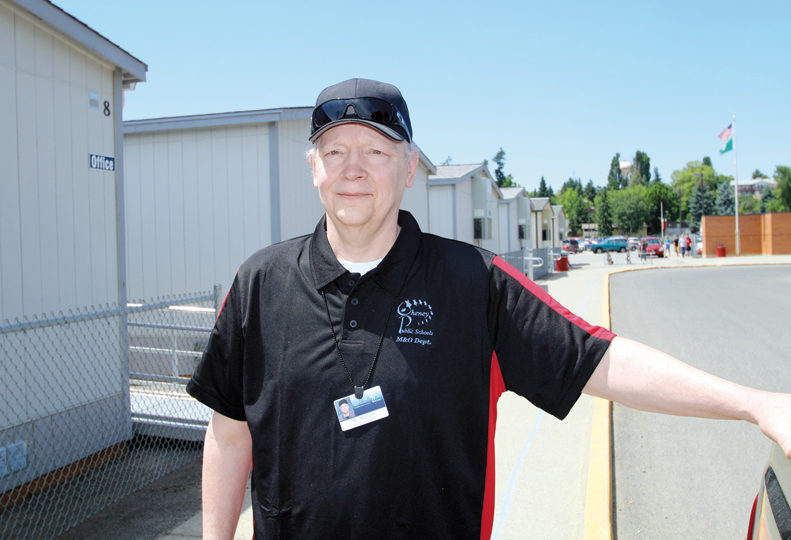
Home » Cheney schools ready for overhaul
Cheney schools ready for overhaul
$52M in projects to ease crowding in growing district

June 8, 2017
Jeff McClure has spent 33 years working for the Cheney School District, the last 12 in his current role as the district’s maintenance and operations director. There may be no one affiliated with the district happier than McClure since Cheney district taxpayers passed a $52 million bond issue for school improvements and classroom additions in February.
The voter-approved measure, slightly larger than one voters rejected two years ago, is expected to provide space to accommodate growth at the elementary, middle, and high school levels through 2028, at current enrollment projections, McClure says.
The focus for now will be on finishing design work on the range of planned projects, so construction work on the first of them probably won’t begin until next year.
The bulk of the money—$35.1 million—will go toward the expansion and renovation of Cheney High School. The school was built in 1966 and was last renovated in 1994. Cheney High was originally designed to accommodate 900 students, McClure says, but the Washington state Office of Superintendent of Public Instruction says its enrollment was at 1,265 students to start the 2016-17 school year.
In all, the district now has a record-high enrollment of 4,500 students, McClure says.
Cheney High School, located at 460 N. Sixth, relies on eight portable facilities to accommodate all its students, he says.
“Portables, nobody likes portables. I certainly didn’t like spending money on portable buildings,” McClure says. Portable classrooms require additional maintenance, and the overall education experience for students is better when they’re housed in a single building, he says.
But the school district’s growth in recent years made it necessary to acquire portable buildings to help alleviate classroom overcrowding.
“We’ve been growing at about 100 kids per year for several years,” says McClure. Cheney Public Schools currently include five elementary schools, two middle schools, Cheney High, an alternative high school, and one home school program, he says.
School district Superintendent Robert Roettger says he was excited, and relieved, when district residents passed the bond measure.
“It was great to see the community step up and recognize its needs,” Roettger says. “The community support, a 64-percent yes vote, was fantastic.”
At Cheney High, district officials say $9 million will be spent toward renovations, $7.1 million for additional classrooms, $6.6 million for a new auditorium, and $6.4 million towards a new practice gym, a wrestling room, and weights and fitness center.
The remainder of the bond money for the high school will be spent on a secured entry, site work, and a new telephone and security system, says a bond information document mailed to district residents before the February bond vote.
Other Cheney schools that are to receive upgrades are elementary schools Betz, Salnave, Sunset, and Windsor. Betz, located next door to the high school at 317 N. Seventh, will receive a new wing; Salnave, at 1015 Salnave in Cheney, a secured entry; Sunset, at 12824 W. 12th in Airway Heights, a new gym; and Windsor, at 5504 W. Hallett inside Spokane’s city limits, a new wing and cafeteria, McClure says.
The bond’s appropriation calls for $7.8 million worth of work at Sunset, $7.25 million at Windsor, $3.2 million at Betz, and $100,000 at Salnave, bond documents say.
The school district’s alternative high school, Three Springs High, is housed on the Cheney High School campus in two portable buildings. The district plans to purchase new land and use part of it to relocate Three Springs to another site. The district has set aside $750,000 for possible future land purchases, McClure says.
Spokane-based ALSC Architects PS is in the beginning stages of drafting architectural renderings for the elementary school projects. McClure says the renderings should be complete by the end of 2017, with the projects going out for bid to general contractors next year.
Cheney High School will use a general contractor/construction manager process. Under the GCCM method, the general contractor participates as an adviser during the design process. McClure says district officials are still establishing time frames for construction starts and project end dates.
A district study completed last April showed that much of the district’s southern portion is sparsely populated, with nearly all the district’s population centered in Cheney, Airway Heights, and West Plains areas.
Cheney applied for, and received, a grant from the Washington state Office of Superintendent of Public Instruction for the study, which was completed by Pullman-based Design West Architects PA last year.
Design West Architects said the Cheney School District should consider another facilities initiative in the mid-2020s to take advantage of state match funds for additional modernizations of existing schools.
The study also called for the district to consider building a new 500-student elementary school and a new, 1,000-student high school in the West Plains portion of the district.
In 2010, Cheney School District voters approved a $79 million bond measure for constructing two middle schools and an elementary school. But in 2015, voters rejected a $49 million bond for renovations and classroom additions at its older elementary schools and the high school.
Across the district, McClure says the Cheney School District is using a total of 18 portable buildings to alleviate overcrowding, which is occurring at most schools.
“The passage of the bond provided a real sense of relief for us,” Roettger says. “It allows us to be able to meet our anticipated needs over the course of the next 10 years.”
Latest News Real Estate & Construction Education & Talent
Related Articles
Related Products
Related Events




_web.jpg?1729753270)